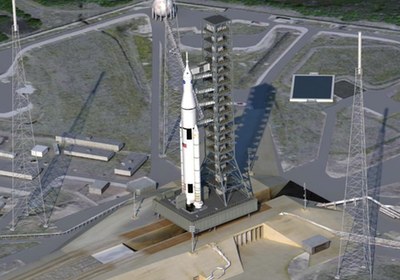The downhill slide of NASA’s “rocket to nowhere”by R.D. Boozer
|
| The GAO report concluded the initial launch date of SLS Block 1 may slip from late 2017 to mid-2018, and mentioned that the slippage is likely to get worse as time goes on. |
In 2011, NASA administrator Charles Bolden commissioned Booz Allen Hamilton (BAH) to do an analysis of the shuttle-derived SLS. This action was taken after it became clear that Congress was determined to implement this hyper-expensive launch vehicle, rather than developing the more economically practical alternative technology needed for deep spaceflight that was specified in NASA’s prior proposal to the legislature in 2010. In one of my earlier articles here (see “Dennis Tito’s ‘Spaceship to Everywhere’ may be a dead-end for NASA”, The Space Review, April 7, 2014), I summarized the BAH report as follows:
SLS will probably stay on schedule within its assigned budget for the first three to five years of development. “Beyond this horizon, the inclusion of large expected cost savings in the estimates, the beginning of development activities, and the potential for significant risk events” decreased the confidence of the BAH report’s authors. This situation would result from SLS being restricted to an annual budget of a size that Congress will actually appropriate. It renders meaningless the claim that SLS’s meeting of its current development schedule is an indicator that the rocket is viable, since the total development time to date is still within the five-year window specified in the BAH report. In fact, the report says that after the window period, it is likely the amount of time between the accomplishment of the developmental goals will get stretched further and further apart.
It’s possible the initiation of the BAH study was a precautionary move by Bolden. That is, in the likely event that SLS habitually doesn’t meet its timeline goals and Congress looks to use the NASA administrator as a scapegoat, Bolden can point to the report and say he tried to warn them. After all, the Ares I launcher of the earlier Constellation Program met the same fate for similar reasons, while consuming many billions of dollars in the process. Given that almost all of the same disadvantages that hobbled Ares I apply to SLS as well (outdated and expensive shuttle-derived technology, excessively costly contracting methods, and so on), it would probably have been obvious to Bolden how SLS was virtually certain to end.
According to a recent report from the Government Accountability Office (GAO), the BAH report was indeed prescient. The GAO report concluded the initial launch date of SLS Block 1 may slip from late 2017 to mid-2018, and for the reasons mentioned in the earlier BAH report. And, like the BAH report, the GAO mentioned that the slippage is likely to get worse as time goes on. This fact is in stark contradiction of statements recently made by SLS prime contractor Boeing, which indicated that SLS development was months ahead of schedule (see “Making progress, and seeking stability, with SLS and Orion”, The Space Review, May 27, 2014).
Sometime in 2015, SpaceX plans to perform the inaugural launch of the Falcon Heavy rocket. When it flies, it will be the most powerful rocket since the Saturn V that sent astronauts to the Moon. Its entire development costs will have been paid for by SpaceX on its own. As I mentioned on page 61 of a book I released last year called The Plundering of NASA: “Now ponder this idea. If SpaceX can build a rocket with three quarters of the payload capacity of the SLS Block 1 without taxpayer money, what could they do with just a fraction of the money that is being spent on SLS?”
| Considering the evidence as presented by both the new GAO report and the earlier BAH study, it is reasonable to conclude that the SLS development program was doomed before it even got started. |
Indeed, before Congress forced SLS on NASA, it asked both United Launch Alliance and SpaceX to submit proposals to develop a super rocket with capabilities similar to the most powerful proposed version of the SLS. The quoted costs with fixed priced contracts were many billions of dollars less than the most optimistic cost projections for SLS. What’s more, it appears that going the SLS route has increased US reliance on Russian rocket technology for both the Department of Defense and NASA because it has taken funds away from efforts that would have weaned us from that dependence (see “NASA’s big rocket gives Putin a big advantage”, The Space Review, June 16, 2014).
Considering the evidence as presented by both the new GAO report and the earlier BAH study, it is reasonable to conclude that the SLS development program was doomed before it even got started. Once the Falcon Heavy is flying, SLS’s developmental shortcomings will be hard to ignore. Since SpaceX is already working on a methane-powered rocket engine called Raptor for use in a rocket even more powerful than the largest proposed version of SLS, it seems the writing is on the wall. Events in the near future will spell doom for SLS.
